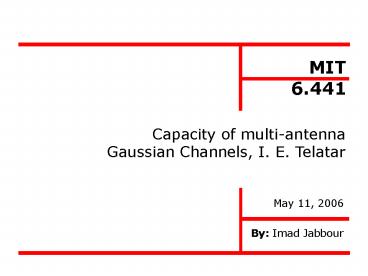Capacity of multi-antenna Gaussian Channels, I. E. Telatar - PowerPoint PPT Presentation
Title:
Capacity of multi-antenna Gaussian Channels, I. E. Telatar
Description:
... Deterministic Fading Channel (1) Deterministic Fading Channel (2) Deterministic Fading Channel (3) Random Varying Channel (1) Random Varying Channel (2) ... – PowerPoint PPT presentation
Number of Views:135
Avg rating:3.0/5.0
Title: Capacity of multi-antenna Gaussian Channels, I. E. Telatar
1
MIT 6.441
- Capacity of multi-antenna Gaussian Channels, I.
E. Telatar
May 11, 2006
By Imad Jabbour
2
Introduction
- MIMO systems in wireless comm.
- Recently subject of extensive research
- Can significantly increase data rates and reduce
BER - Telatars paper
- Bell Labs (1995)
- Information-theoretic aspect of single-user MIMO
systems - Classical paper in the field
3
Preliminaries
- Wireless fading scalar channel
- DT Representation
- H is the complex channel fading coefficient
- W is the complex noise,
- Rayleigh fading , such that H is
Rayleigh distributed - Circularly-symmetric Gaussian
- i.i.d. real and imaginary parts
- Distribution invariant to rotations
4
MIMO Channel Model (1)
- I/O relationship
- Design parameters
- t Tx. antennas and r Rx. antennas
- Fading matrix
- Noise
- Power constraint
- Assumption
- H known at Rx. (CSIR)
5
MIMO Channel Model (2)
- System representation
- Telatar the fading matrix H can be
- Deterministic
- Random and changes over time
- Random, but fixed once chosen
Transmitter
Receiver
6
Deterministic Fading Channel (1)
- Fading matrix is not random
- Known to both Tx. and Rx.
- Idea Convert vector channel to a parallel one
- Singular value decomposition of H
- SVD , for U and V unitary, and D diagonal
- Equivalent system , where
- Entries of D are the singular values of H
- There are singular values
7
Deterministic Fading Channel (2)
- Equivalent parallel channel nminmin(r,t)
- Tx. must know H to pre-process it, and Rx. must
know H to post-process it
8
Deterministic Fading Channel (3)
- Result of SVD
- Parallel channel with sub-channels
- Water-filling maximizes capacity
- Capacity is
- Optimal power allocation
- is chosen to meet total power constraint
9
Random Varying Channel (1)
- Random channel matrix H
- Independent of both X and W, and memoryless
- Matrix entries
- Fast fading
- Channel varies much faster than delay requirement
- Coherence time (Tc) period of variation of
channel
10
Random Varying Channel (2)
- Information-theoretic aspect
- Codeword length should average out both additive
noise and channel fluctuations - Assume that Rx. tracks channel perfectly
- Capacity is
- Equal power allocation at Tx.
- Can show that
- At high power, C scales linearly with nmin
- Results also apply for any ergodic H
11
Random Varying Channel (3)
- MIMO capacity versus SNR (from 2)
12
Random Fixed Channel (1)
- Slow fading
- Channel varies much slower than delay requirement
- H still random, but is constant over transmission
duration of codeword - What is the capacity of this channel?
- Non-zero probability that realization of H does
not support the data rate - In this sense, capacity is zero!
13
Random Fixed Channel (2)
- Telatars solution outage probability pout
- pout is probability that R is greater that
maximum achievable rate - Alternative performance measure is
- Largest R for which
- Optimal power allocation is equal allocation
across only a subset of the Tx. antennas.
14
Discussion and Analysis (1)
- Whats missing in the picture?
- If H is unknown at Tx., cannot do SVD
- Solution V-BLAST
- If H is known at Tx. also (full CSI)
- Power gain over CSIR
- If H is unknown at both Tx. and Rx (non-coherent
model) - At high SNR, solution given by Marzetta
Hochwald, and Zheng - Receiver architectures to achieve capacity
- Other open problems
15
Discussion and Analysis (2)
- If H unknown at Tx.
- Idea multiplex in an arbitrary coordinate system
B, and do joint ML decoding at Rx. - V-BLAST architecture can achieve capacity
16
Discussion and Analysis (3)
- If varying H known at Tx. (full CSI)
- Solution is now water-filling over space and time
- Can show optimal power allocation is P/nmin
- Capacity is
- What are we gaining?
- Power gain of nt/nmin as compared to CSIR case
17
Discussion and Analysis (4)
- If H unknown at both Rx. and Tx.
- Non-coherent channel channel changes very
quickly so that Rx. can no more track it - Block fading model
- At high SNR, capacity gain is equal to (Zheng)
18
Discussion and Analysis (5)
- Receiver architectures 2
- V-BLAST can achieve capacity for fast
Rayleigh-fading channels - Caveat Complexity of joint decoding
- Solution simpler linear decoders
- Zero-forcing receiver (decorrelator)
- MMSE receiver
- MMSE can achieve capacity if SIC is used
19
Discussion and Analysis (6)
- Open research topics
- Alternative fading models
- Diversity/multiplexing tradeoff (Zheng Tse)
- Conclusion
- MIMO can greatly increase capacity
- For coherent high SNR,
- How many antennas are we using?
- Can we beat the AWGN capacity?
20
Thank you!
- Any questions?































